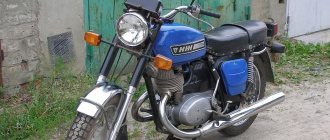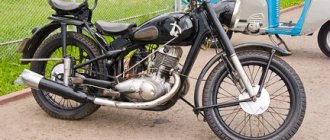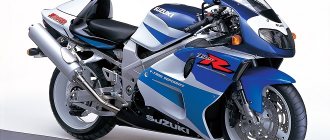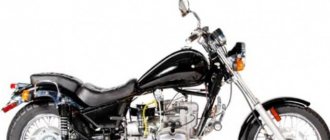The steel heavyweight called the Ural M-63 is considered one of the most powerful motorcycles of the Soviet period. This technique is quite “gluttonous”, but has great power. This vehicle, equipped with a sidecar, can be actively used for any rural purpose.
This model was produced at the Irbit Motorcycle Plant from 1963 to 1980. This modification has a number of differences from its ancestors. Firstly, the model is equipped with a frame with a pendulum-type suspension on the rear wheel. Secondly, it is equipped with springs with hydraulic shock-absorbing elements in the rear, which later came in handy on a stroller wheel. The developers also significantly expanded the ground clearance and introduced a new type of exhaust unit design.
general description
The Ural M-63 motorcycle has a length of 2.42 meters. At the same time, the width of the vehicle was 1.57 m. The height of the bike was 1.1 m. The dry weight of the heavy iron horse was neither more nor less - 320 kg.
The equipment in question can withstand more than 250 kilograms of cargo without any consequences. The recommended speed of the bike is within 100 km/h. The power plant is equipped with an overhead valve system, the working volume is 650 cubic centimeters. The cylinder size is 780 mm with a moderate compression ratio (6.2). The maximum power of this heavyweight with three wheels is 28 horsepower.
The crankshaft on the Ural M-63 motorcycle spins at maximum speed at 5200 rpm. Decent fuel consumption was partially compensated by a spacious 22-liter fuel tank. The modification is equipped with a six-volt power supply system and a “K-301” carburetor.
Notes
| Components | |||||||||||||||||||||||||||||||||||
Engine
| |||||||||||||||||||||||||||||||||||
| Clutch | dry double-disc | ||||||||||||||||||||||||||||||||||
| checkpoint |
| ||||||||||||||||||||||||||||||||||
| Fuel supply | by gravity | ||||||||||||||||||||||||||||||||||
| Front tire | |||||||||||||||||||||||||||||||||||
| Rear tire | |||||||||||||||||||||||||||||||||||
| Specifications | |||||||||||||||||||||||||||||||||||
| Tank capacity | |||||||||||||||||||||||||||||||||||
| Maximum speed, km/h | |||||||||||||||||||||||||||||||||||
| Dimensions | |||||||||||||||||||||||||||||||||||
| Length, mm | |||||||||||||||||||||||||||||||||||
| Width, mm | |||||||||||||||||||||||||||||||||||
| Height, mm | |||||||||||||||||||||||||||||||||||
| Motorcycle base, mm | |||||||||||||||||||||||||||||||||||
| Ground clearance, mm | |||||||||||||||||||||||||||||||||||
Peculiarities
"Ural M-63", the characteristics of which allow the motorcycle to be used as a tractor for a tow hitch, has drive to both the rear wheel and the sidecar, which improves traction with the road surface.
When creating the power unit, special attention was paid to the development of the gas distribution system. Innovative solutions ultimately led to increased rigidity of the valve drive and reduced contact stress by increasing the dimensions of the camshaft journals. In addition, the motor has one more nuance: the front placement of the connecting rod and crank mechanism, unlike its predecessor, which allows the oil catchers to be expanded by nine millimeters.
The size of the motorcycle is similar to that of a small car. This makes it difficult to maneuver with the stroller attached in narrow areas. The large luggage compartment located in the rear of the stroller also plays an important role. You can carry a decent amount of luggage there.
The performance of the vehicle in question makes it an excellent assistant for rural areas. However, it is quite difficult to purchase such a device in working condition. For serviceable models that have undergone restoration, the price starts from 250 thousand rubles.
History and design
The immediate impetus for the design of the M-63 was the decision of a special commission to unify the motorcycles of the Irbit and Kyiv motorcycle plants. The design differences of these machines, sometimes small, made the interchangeability of individual components and parts impossible. Carrying out this decision, the IMZ design team designed the M-63 motorcycle. Its main components and assemblies are interchangeable with the components and assemblies of the K-650 motorcycle, the production of which was to be mastered in Kyiv. The M-63 motorcycle, unlike its predecessors, is equipped with a frame with a pendulum suspension of the rear wheel. The new exhaust system has significantly reduced exhaust noise; the mufflers are raised above the ground (when the motorcycle is fully loaded, the clearance is 150 mm).
Engine M-63
is in many ways similar to the M-61 and M-62, but has fundamental design features.
The crank is installed in the crankcase not from the rear, like the M-62 engine, but from the front, so the front bearing housing (it is made of aluminum alloy with a steel ring cast into it) has a mounting diameter of 142 mm, and the rear bearing housing is only 78 mm. The width of the oil traps has been increased to 9 mm, which improves oil purification.
The gear oil pump is located under the front engine cover, and its housing is integral with the front bearing housing. The oil pump is driven by a timing gear mounted on the front end of the crank.
The design of the engine crankcase is highly technological and simple; its weight is much less than that of the M-62 (even the weight of the experimental crankcase, made by casting into the ground, turned out to be 700 grams less compared to the old production one).
When designing the gas distribution mechanism, special attention was paid to increasing the rigidity of the valve drive and reducing contact stresses on the cams. This was achieved by increasing the diameter of the camshaft journals, replacing the sliding bearing with a rolling bearing, increasing the cross-section of the tubular steel rod and placing the pusher and rod in line (in the M-61 and M-62 engines the rod is inclined relative to the pusher at an angle of 8-9 degrees). These design measures, combined with a special cam profile, reduce the noise level of the valve train. A new profile of the gas distribution cam, an increase in the radius of its back and the width of the cams, and the use of cast iron tappets rotating around their axis made it possible to significantly reduce wear on both the tappets themselves and the camshaft.
The breather, which has the shape of a disk and is pressed against the front cover by a spring during operation, provides a large vacuum in the engine crankcase in all operating modes. The wear of the working end of the breather and the front cover to which it is pressed is compensated by the corresponding movement of the breather under the action of the spring.
The Irbit Motor Plant produced the first industrial batch of Ural-2 motorcycles, model M-63, in 1964. At first, the M-63 was equipped with engines from the M-62 Ural motorcycle, but with some changes. The modernized M-62 engine had strengthened exhaust valves, crank pins, connecting rods, and pistons.
Motorcycle gearbox
“Ural-2” is finely splined, similar to the M-62 “Ural”, but the weak point of the previous box has been eliminated - the axle and bushing of the foot switch pedal quickly wore out. The new closed-type gear shift mechanism operates in an oil bath and is protected from dust and dirt. This improved both the appearance and simplified the design of the gearbox, which was also installed on the K-750 motorcycle.
Cardan drive:
The driveshaft is still used to drive the rear wheel. Moreover, the shaft on the M-63 is moved away from the wheel by 5 mm, since it was planned that motorcycles from the Irbit plant would be produced on wider tires (4″ X 17″). A more reliable double-lip collar seal is installed in the main gear.
Chassis
underwent a radical reconstruction. For the first time on production IMZ motorcycles, a pendulum suspension with spring-hydraulic shock absorbers was introduced to suspend the rear wheel (later a similar suspension was introduced on the sidecar wheel), which significantly increased the comfort of the motorcycle and its durability. The hydraulic part of the rear shock absorbers is almost completely borrowed from the shock absorbers of the Moskvich car. The pendulum fork of the rear wheel is installed in the frame on rubber silent blocks. The front wheel suspension remained the same design, but became the same for motorcycles from the Irbit and Kyiv motorcycle factories. The new mud flaps have a wider profile, are installed above the wheel with large gaps, and have special rubber mud flaps in the lower part. The gas tank has also changed and has become easier to manufacture.
Technical indicators
The Ural M-63 motorcycle, the technical characteristics of which are given below, cannot be called an economical vehicle, although at a time when gasoline prices were cheap, its power was one of the leading in its class.
Basic technical data:
- Overall length/width/height (mm) – 2420/1570/1100.
- Wheelbase (mm) – 1450.
- Weight (kg) – 320.
- Maximum speed limit (km/h) – 100.
- Power (hp) – 21.
- Maximum load (kg) – 255.
- Gas tank volume (l) – 22.
The model in question is also equipped with a telescopic front suspension with shock absorbers using double-acting hydraulics. The rear suspension is lever type with spring elements. The motorcycle brakes are shoe brakes with friction linings. The dry disc clutch interacts with the cardan drive.
An excerpt characterizing the IMZ M-63
Having released the generals, Kutuzov sat for a long time, leaning on the table, and kept thinking about the same terrible question: “When, when was it finally decided that Moscow was abandoned?
When was what was done that resolved the issue, and who is to blame for this?” “I didn’t expect this, this,” he said to Adjutant Schneider, who came to him late at night, “I didn’t expect this!” I didn't think that! “You need to rest, Your Grace,” said Schneider. - No! “If they eat horse meat like the Turks,” Kutuzov shouted without answering, hitting the table with his plump fist, “they will too, if only... In contrast to Kutuzov, at the same time, in an event even more important than the retreat of the army without battle, in abandoning Moscow and burning it, Rostopchin, who seems to us to be the leader of this event, acted completely differently. This event - the abandonment of Moscow and its burning - was as inevitable as the retreat of the troops without a fight for Moscow after the Battle of Borodino. Every Russian person, not on the basis of conclusions, but on the basis of the feeling that lies in us and lay in our fathers, could have predicted what happened. Starting from Smolensk, in all the cities and villages of the Russian land, without the participation of Count Rastopchin and his posters, the same thing happened that happened in Moscow. The people blithely waited for the enemy, did not rebel, did not worry, did not tear anyone to pieces, but calmly waited for their fate, feeling the strength in themselves in the most difficult moment to find what they had to do. And as soon as the enemy approached, the richest elements of the population left, leaving their property; the poorest remained and set fire and destroyed what was left. The consciousness that it will be so, and will always be so, lay and lies in the soul of the Russian person. And this consciousness and, moreover, the premonition that Moscow would be taken, lay in the Russian Moscow society of the 12th year. Those who began to leave Moscow back in July and early August showed that they were expecting this. Those who left with what they could seize, leaving their houses and half their property, acted this way due to that latent patriotism, which is expressed not by phrases, not by killing children to save the fatherland, etc. by unnatural actions, but which is expressed imperceptibly, simply, organically and therefore always produces the most powerful results. “It is a shame to run from danger; only cowards are fleeing Moscow,” they were told. Rastopchin in his posters inspired them that leaving Moscow was shameful. They were ashamed to be called cowards, they were ashamed to go, but they still went, knowing that it was necessary. Why were they going? It cannot be assumed that Rastopchin frightened them with the horrors that Napoleon produced in the conquered lands. They left, and the first to leave were rich, educated people who knew very well that Vienna and Berlin remained intact and that there, during their occupation by Napoleon, the inhabitants had fun with the charming Frenchmen, whom Russian men and especially ladies loved so much at that time. They traveled because for the Russian people there could be no question: whether it would be good or bad under the rule of the French in Moscow. It was impossible to be under French control: that was the worst thing. They left before the Battle of Borodino, and even faster after the Battle of Borodino, despite appeals for protection, despite statements by the commander-in-chief of Moscow about his intention to raise Iverskaya and go to fight, and to the balloons that were supposed to destroy the French, and despite all that nonsense that Rastopchin talked about in his posters. They knew that the army had to fight, and that if it couldn’t, then they couldn’t go to the Three Mountains with the young ladies and servants to fight Napoleon, but that they had to leave, no matter how sorry it was to leave their property to destruction. They left and did not think about the majestic significance of this huge, rich capital, abandoned by the inhabitants and, obviously, burned (a large abandoned wooden city had to burn); they left each for themselves, and at the same time, only because they left, that magnificent event took place, which will forever remain the best glory of the Russian people. That lady who, back in June, with her araps and firecrackers, rose from Moscow to the Saratov village, with a vague consciousness that she was not Bonaparte’s servant, and with fear that she would not be stopped on the orders of Count Rastopchin, did simply and truly that great the case that saved Russia. Count Rostopchin, who either shamed those who were leaving, then took away public places, then gave out useless weapons to drunken rabble, then raised images, then forbade Augustine to take out relics and icons, then seized all the private carts that were in Moscow, then one hundred and thirty-six carts carried away a balloon made by Leppich, either hinting that he would burn Moscow, or telling how he burned down his house and wrote a proclamation to the French, where he solemnly reproached them for ruining his orphanage; either accepted the glory of burning Moscow, then renounced it, then ordered the people to catch all the spies and bring them to him, then reproached the people for this, then expelled all the French from Moscow, then left Madame Aubert Chalmet in the city, who formed the center of the entire French Moscow population , and without much guilt he ordered the old venerable postal director Klyucharyov to be captured and taken into exile; either he gathered people to the Three Mountains to fight the French, then, in order to get rid of these people, he gave them a person to kill and he himself left for the back gate; either he said that he would not survive the misfortune of Moscow, or he wrote poems in French in albums about his participation in this matter - this man did not understand the significance of the event that was taking place, but just wanted to do something himself, to surprise someone, to do something patriotically heroic and, like a boy, he frolicked over the majestic and inevitable event of the abandonment and burning of Moscow and tried with his small hand to either encourage or delay the flow of the huge stream of people that carried him away with it.
Helen, having returned with the court from Vilna to St. Petersburg, was in a difficult situation. In St. Petersburg, Helen enjoyed the special patronage of a nobleman who occupied one of the highest positions in the state. In Vilna, she became close to a young foreign prince. When she returned to St. Petersburg, the prince and the nobleman were both in St. Petersburg, both were claiming their rights, and Helen was faced with a new task in her career: to maintain her close relationship with both without offending either. What would have seemed difficult and even impossible for another woman never made Countess Bezukhova think twice about it, and it was not without reason that she apparently enjoyed the reputation of being the smartest woman. If she began to hide her actions, to extricate herself from an awkward situation by cunning, she would thereby ruin her case, recognizing herself as guilty; but Helen, on the contrary, immediately, like a truly great person who can do whatever she wants, put herself in the position of rightness, in which she sincerely believed, and all others in the position of guilt. The first time a young foreign person allowed himself to reproach her, she, proudly raising her beautiful head and turning half a turn to him, firmly said: “Voila l'egoisme et la cruaute des hommes!” Je ne m"attendais pas autre chose. Za femme se sacrifie pour vous, elle souffre, et voila sa recompense. Quel droit avez vous, Monseigneur, de me demander compte de mes amities, de mes affections? C"est un homme qui a ete plus qu"un pere pour moi. [This is the selfishness and cruelty of men! I didn't expect anything better. The woman sacrifices herself to you; she suffers, and this is her reward. Your Highness, what right do you have to demand from me an account of my affections and friendly feelings? This is a man who was more than a father to me.] The face wanted to say something. Helen interrupted him. “Eh bien, oui,” she said, “peut etre qu”il a pour moi d”autres sentiments que ceux d”un pere, mais ce n”est; pas une raison pour que je lui ferme ma porte. Je ne suis pas un homme pour être ingrate. Sachez, Monseigneur, pour tout ce qui a rapport a mes sentiments intimes, je ne rends compte qu»a Dieu et a ma conscience, [Well, yes, maybe the feelings he has for me are not entirely paternal; but because of this I shouldn’t refuse him my home. I am not a man to pay with ingratitude. Let it be known to your Highness that in my sincere feelings I give an account only to God and my conscience.] - she finished, touching her beautiful breasts that rose high with her hand and looking at the sky.
Owner reviews
The Ural M-63 motorcycle is a true legend of the Soviet automotive industry. Its maneuverability and power are impressive. Owners of the unit highlight the following advantages:
- Spacious side trailer along with high load capacity.
- Powerful power unit, reliability.
- Soft suspension, ease of operation and repair.
- Thoughtful design of lighting elements.
Like any technology, the vehicle in question has its drawbacks. Consumers among them note high fuel consumption, difficulty driving without a stroller, hard seats and a weak battery for such a weight.











